Nondestructive Evaluation of Thermal Barrier Coatings Interface Delamination Using Terahertz Technique Combined with SWT-PCA-GA-BP Algorithm
Abstract
1. Introduction
2. Simulations and Modeling
2.1. Terahertz Simulation Signal Obtained by FDTD Algorithm
2.2. Data Processing and Feature Extraction
2.3. Hybrid Artificial Neural Network Model
- Determine the basic structure of BP neural network, including the number of the input neurons, the hidden neurons, the output neurons, and the hidden layers.
- Encoding. The formula for calculating the length of the code can be expressed aswhere is the code length, , and are the input neuron number, hidden neuron number and output neuron number, respectively.
- Design the degree of fitness function. The fitness function is employed to measure the merit degree. In this work, the degree of fitness function was designed based on the prediction index mean squared error.
- Define the genetic algorithm parameters and initialize the population. The optimization algorithm parameters include the population size, the iteration number, the variation probability, and the crossover probability.
- Estimate the fitness value of the population according to the fitness function designed in Step (3).
- Use the fitness value as the basis for selection, crossing, and variation of the population. If the termination condition is met, the calculation is terminated; if not, return back to Step (5) until the termination condition is achieved.
- Decode the optimal individuals in the population as initial weights and thresholds and train the BP model.
- Test the BP model performance after training completion.
3. Results and Discussion
4. Conclusions
- It was found that FDTD model could be used to simulate the propagation process of terahertz waves in the TBCs with various thicknesses of interface delamination. The simulated terahertz time-domain signals after SWT processing showed that the detail coefficient kept the main characteristic peak position of raw signals and also adjusted waveform baseline.
- The PCA approach could be effectively used to reduce the SWT data dimension to improve the computational speed during modeling, the top 31 PCs were chosen instead of the original SWT signals as the input data during machine learning modeling, owing to their cumulative contribution rate (100%).
- To get the prediction accuracy and reliability of the BP model improved, the GA algorithm was employed to optimize the BP model. Finally, the hybrid SWT-PCA-GA-BP regression model with high R2 value (>0.95) and low error values (≤0.5300) were obtained, the hybrid SWT-PCA-GA-BP model showed its high accuracy and reliability in predicting the thickness of interface delamination, hence, it could be potentially used to monitor the TBCs delamination progression starting from the early stage of subcritical delamination crack propagation.
- Additionally, this novel terahertz nondestructive technology combined hybrid artificial neural network would be potentially applied in the future to monitor and improve the service life of TBCs.
Author Contributions
Funding
Conflicts of Interest
References
- Padture, N.P.; Gell, M.; Jordan, E.H. Thermal barrier coatings for gas-turbine engine applications. Science 2002, 296, 280–284. [Google Scholar] [CrossRef] [PubMed]
- Nicholls, J.R. Advances in coating design for high-performance gas turbines. MRS Bull. 2003, 28, 659–670. [Google Scholar] [CrossRef]
- Kumar, V.; Balasubramanian, K. Progress update on failure mechanisms of advanced thermal barrier coatings: A review. Prog. Org. Coat. 2016, 90, 54–82. [Google Scholar] [CrossRef]
- Giolli, C.; Scrivani, A.; Rizzi, G.; Borgioli, F.; Lusvarghi, L. Failure mechanism for thermal fatigue of thermal barrier coating systems. J. Therm. Spray Technol. 2009, 18, 223–230. [Google Scholar] [CrossRef]
- Hutchinson, J.W.; Evans, A.G. On the delamination of thermal barrier coatings in a thermal gradient. Surf. Coat. Technol. 2002, 149, 179–184. [Google Scholar] [CrossRef]
- Lv, J.N.; Fan, X.L.; Li, Q. The impact of the growth of thermally grown oxide layer on the propagation of surface cracks within thermal barrier coatings. Surf. Coat. Technol. 2017, 309, 1033–1044. [Google Scholar] [CrossRef]
- Song, D.; Song, T.; Paik, U.; Lyu, G. Crack-growth behavior in thermal barrier coatings with cyclic thermal exposure. Coatings 2019, 9, 365. [Google Scholar] [CrossRef]
- Chen, H.-L.R.; Zhang, B.; Alvin, M.A.; Lin, Y. Ultrasonic detection of delamination and material characterization of thermal barrier coatings. J. Therm. Spray Technol. 2012, 21, 1184–1194. [Google Scholar] [CrossRef]
- Yong, L.; Chen, Z.; Mao, Y.; Yong, Q. Quantitative evaluation of thermal barrier coating based on eddy current technique. NDT E Int. 2012, 50, 29–35. [Google Scholar] [CrossRef]
- Queralt, I.; Ibañez, J.; Marguí, E.; Pujol, J. Thickness measurement of semiconductor thin films by energy dispersive X-ray fluorescence bench-top instrumentation: Application to GaN epilayers grown by molecular beamepitaxy. Spectroc. Acta Part B At. Spectrosc. 2010, 65, 583–586. [Google Scholar] [CrossRef]
- Shrestha, R.; Kim, W. Evaluation of coating thickness by thermal wave imaging: A comparative study of pulsed and lock-in infrared thermography—Part II: Experimental investigation. Infrared Phys. Technol. 2018, 92, 24–29. [Google Scholar] [CrossRef]
- Zhong, S. Progress in terahertz nondestructive testing: A review. Front. Mech. Eng. 2018, 14, 273–281. [Google Scholar] [CrossRef]
- Fukuchi, T.; Fuse, N.; Fujii, T.; Okada, M. Topcoat thickness measurement of thermal barrier coating of gas turbine blade using terahertz wave. Electr. Eng. Jpn. 2014, 189, 1–8. [Google Scholar] [CrossRef]
- Fukuchi, T.; Fuse, N.; Fujii, T.; Okada, M. Measurement of refractive index and thickness of topcoat of thermal barrier coating by reflection measurement of terahertz waves. Electron. Commun. Jpn. 2013, 96, 37–45. [Google Scholar] [CrossRef]
- Luo, M.; Zhong, S.; Yao, L.; Tu, W.; Nsengiyumva, W.; Chen, W. Thin thermally grown oxide thickness detection in thermal barrier coatings based on SWT-BP neural network algorithm and terahertz technology. Appl. Opt. 2020, 59, 4097–4104. [Google Scholar] [CrossRef] [PubMed]
- Chen, C.C.; Lee, D.J.; Pollock, T.; Whitaker, J.F. Pulsed-terahertz reflectometry for health monitoring of ceramic thermal barrier coatings. Opt. Express 2010, 18, 3477–3486. [Google Scholar] [CrossRef]
- Ye, D.; Wang, W.; Zhou, H.; Fang, H.; Huang, J.; Li, Y.; Gong, H.; Li, Z. Characterization of thermal barrier coatings microstructural features using terahertz spectroscopy. Surf. Coat. Technol. 2020, 394, 125836. [Google Scholar] [CrossRef]
- Ye, D.; Wang, W.; Zhou, H.; Huang, J.; Wu, W.; Gong, H.; Li, Z. In-situ evaluation of porosity in thermal barrier coatings based on the broadening of terahertz time-domain pulses: Simulation and experimental investigations. Opt. Express 2019, 27, 28150–28165. [Google Scholar] [CrossRef]
- Ye, D.; Wang, W.; Zhou, H.; Li, Y.; Fang, H.; Huang, J.; Gong, H.; Li, Z. Quantitative determination of porosity in thermal barrier coatings using terahertz reflectance spectrum: Case study of atmospheric-plasma-sprayed YSZ coatings. IEEE Trans. Terahertz Sci. Technol. 2020, 10, 383–390. [Google Scholar] [CrossRef]
- Ye, D.; Wang, W.; Huang, J.; Lu, X. Nondestructive interface morphology characterization of thermal barrier coatings using terahertz time-domain spectroscopy. Coatings 2019, 9, 89. [Google Scholar] [CrossRef]
- Ye, D.; Wang, W.; Zhou, H.; Fang, H.; Huang, J.; Gong, H.; Li, Z. Parallel crack monitoring of thermal barrier coatings based on terahertz technology. Surf. Technol. 2020, 49, 91–97. [Google Scholar]
- Tu, W.; Zhong, S.; Shen, Y.; Atilla, I.; Fu, X. Neural network-based hybrid signal processing approach for resolving thin marine protective coating by terahertz pulsed imaging. Ocean Eng. 2019, 173, 58–67. [Google Scholar] [CrossRef]
- Sullivan, D.M. Electromagnetic Simulation Using the FDTD Method; IEEE Press: Piscataway, NJ, USA, 2013. [Google Scholar]
- Mortazavi, S.H.; Shahrtash, S.M. Comparing denoising performance of DWT, WPT, SWT and DT-CWT for partial discharge signals. In Proceedings of the 43rd International Universities Power Engineering Conference, Padova, Italy, 1–4 September 2008; pp. 1–6. [Google Scholar]
- Jamaluddin, F.N.; Ahmad, S.A.; Noor, S.B.M.; Hassan, W.Z.W.; Yaacob, A.; Adam, Y. Performance of DWT and SWT in muscle fatigue detection. Biomed. Eng. Sci. IEEE 2015, 50–53. [Google Scholar] [CrossRef]
- Dong, J.; Locquet, A.; Citrin, D.S. Enhanced terahertz imaging of small forced delamination in woven glass fibre-reinforced composites with wavelet de-noising. J. Infrared Millim. Terahertz Waves 2015, 37, 289–301. [Google Scholar] [CrossRef]
- Brychta, R.J.; Tuntrakool, S.; Appalsamy, M.; Keller, N.R.; Roberson, D.; Shiavi, R.G.; Diedrich, A. Wavelet methods for spike detection in mouse renal sympathetic nerve activity. IEEE Trans. Biomed. Eng. 2007, 54, 82–93. [Google Scholar] [CrossRef]
- He, F.; Zhang, L. Prediction model of end-point phosphorus content in BOF steelmaking process based on PCA and BP neural network. J. Process Control 2018, 66, 51–58. [Google Scholar] [CrossRef]
- Guo, Z.H.; Wu, J.; Lu, H.Y.; Wang, J.Z. A case study on a hybrid wind speed forecasting method using bp neural network. Knowl.-Based Syst. 2011, 24, 1048–1056. [Google Scholar] [CrossRef]
- Ren, C.; An, N.; Wang, J.; Li, L.; Hu, B.; Shang, D. Optimal parameters selection for bp neural network based on particle swarm optimization: A case study of wind speed forecasting. Knowl.-Based Syst. 2014, 56, 226–239. [Google Scholar] [CrossRef]
- Ma, L.; Wang, B.; Yan, S.; Gu, X. Temperature error correction based on bp neural network in meteorological wireless sensor network. Int. J. Sens. Netw. 2016, 23, 265. [Google Scholar] [CrossRef]
- Ehyaei, M.A.; Rosen, M.A. Optimization of a triple cycle based on a solid oxide fuel cell and gas and steam cycles with a multi-objective genetic algorithm and energy, exergy and economic analyses. Energy Convers. Manag. 2019, 180, 689–708. [Google Scholar] [CrossRef]
- Salah, B.; Ali, F.; Ali, O.; Mohamed, S. Optimal deep learning LSTM model for electric load forecasting using feature selection and genetic algorithm: Comparison with machine learning approaches. Energies 2018, 11, 1636. [Google Scholar]
- Wang, S.; Zhang, N.; Wu, L.; Wang, Y. Wind speed forecasting based on the hybrid ensemble empirical mode decomposition and ga-bp neural network method. Renew. Energy 2016, 94, 629–636. [Google Scholar] [CrossRef]
- Yu, F.; Xu, X. A short-term load forecasting model of natural gas based on optimized genetic algorithm and improved bp neural network. Appl. Energy 2014, 134, 102–113. [Google Scholar] [CrossRef]
- Zheng, D.; Qian, Z.D.; Liu, Y.; Liu, C.B. Prediction and sensitivity analysis of long-term skid resistance of epoxy asphalt mixture based on ga-bp neural network. Constr. Build. Mater. 2018, 158, 614–623. [Google Scholar] [CrossRef]
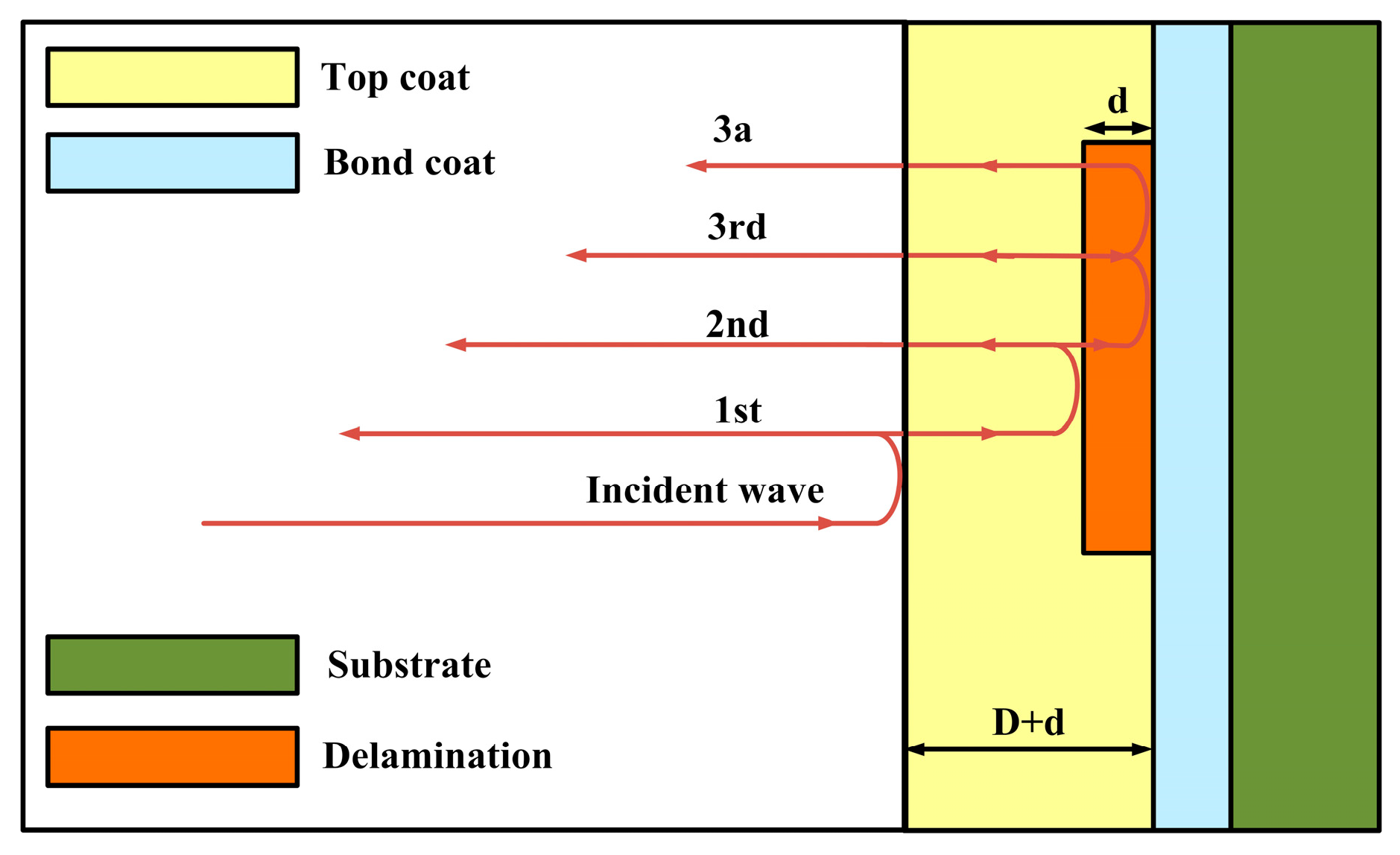
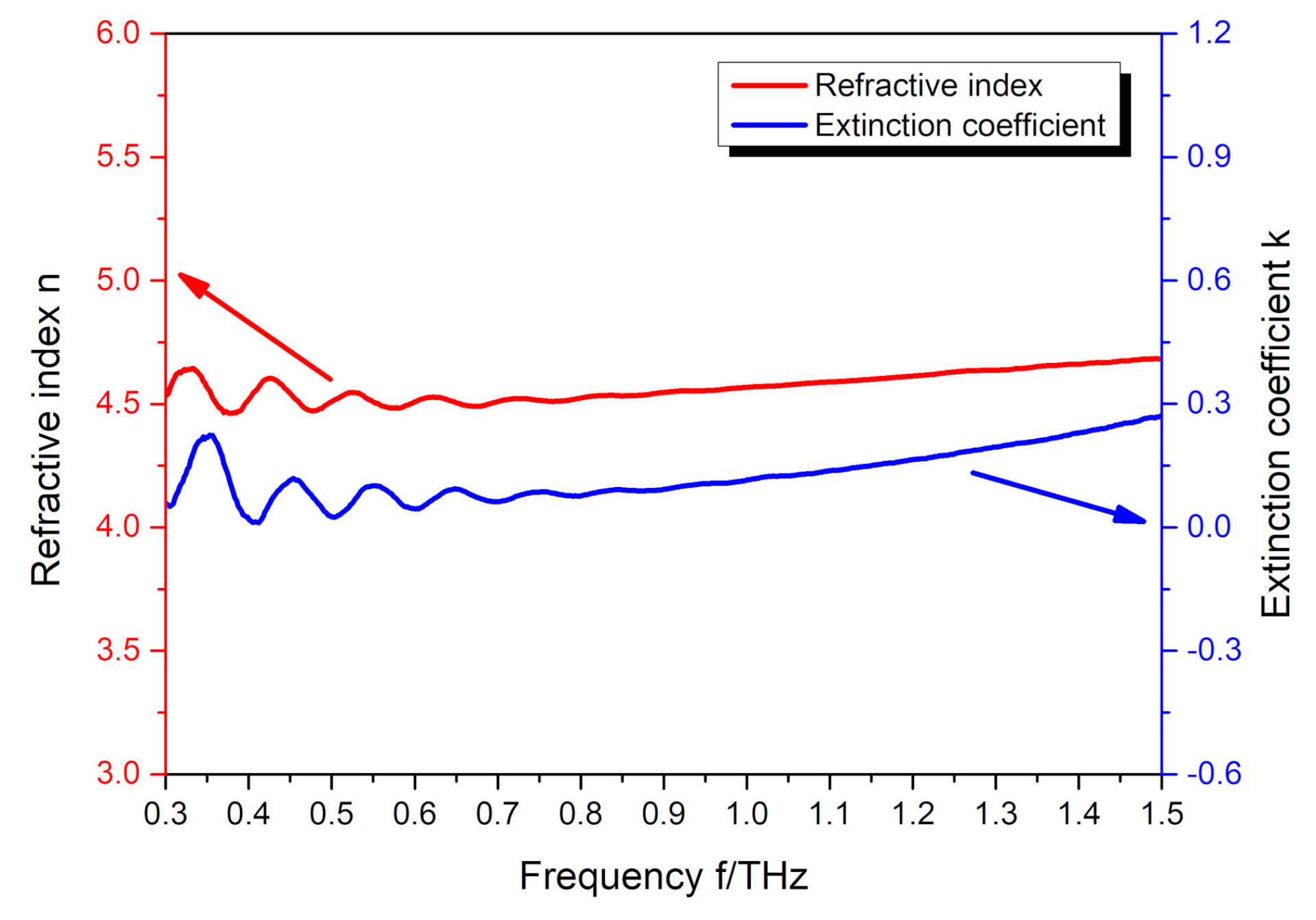

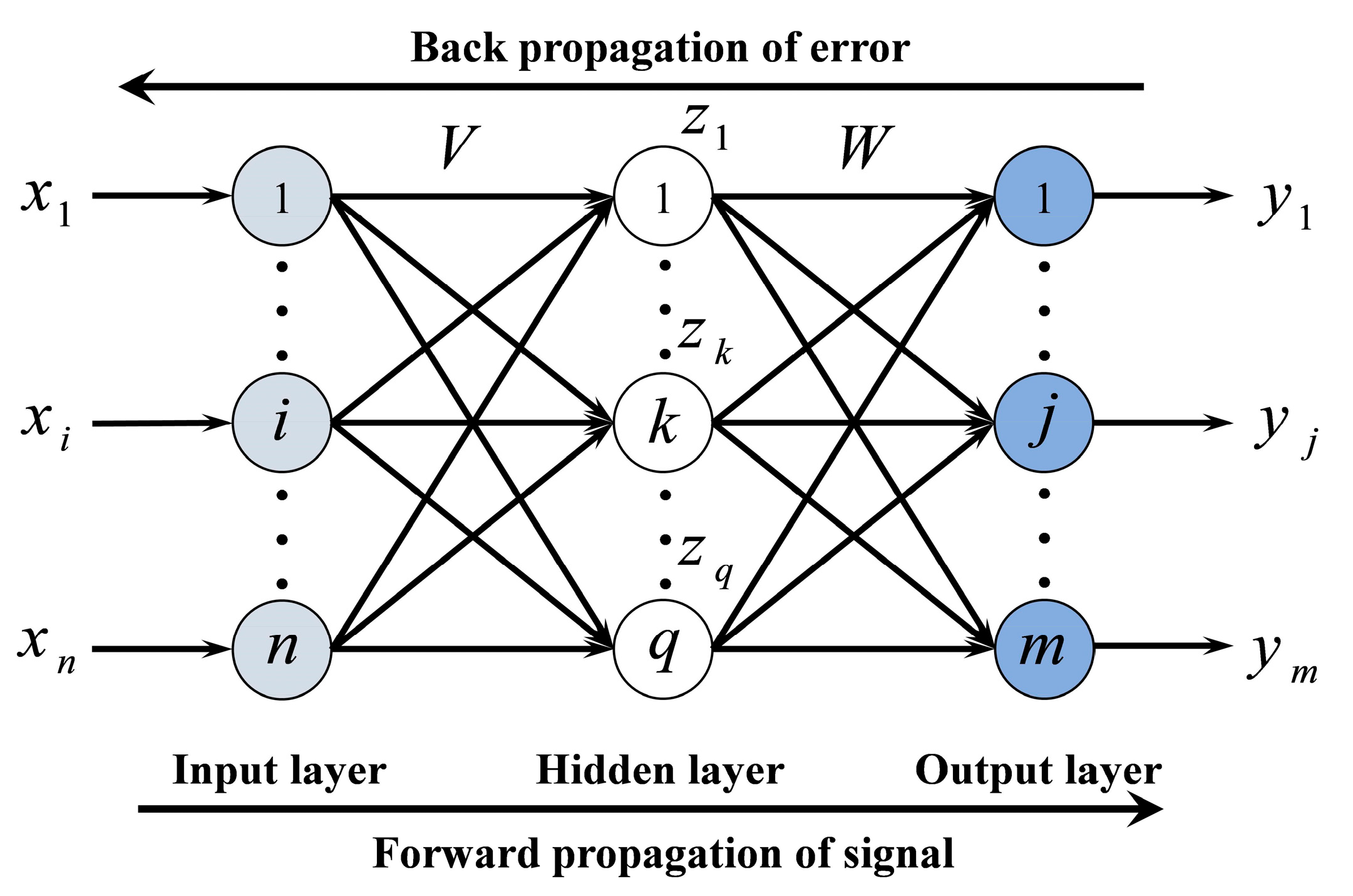
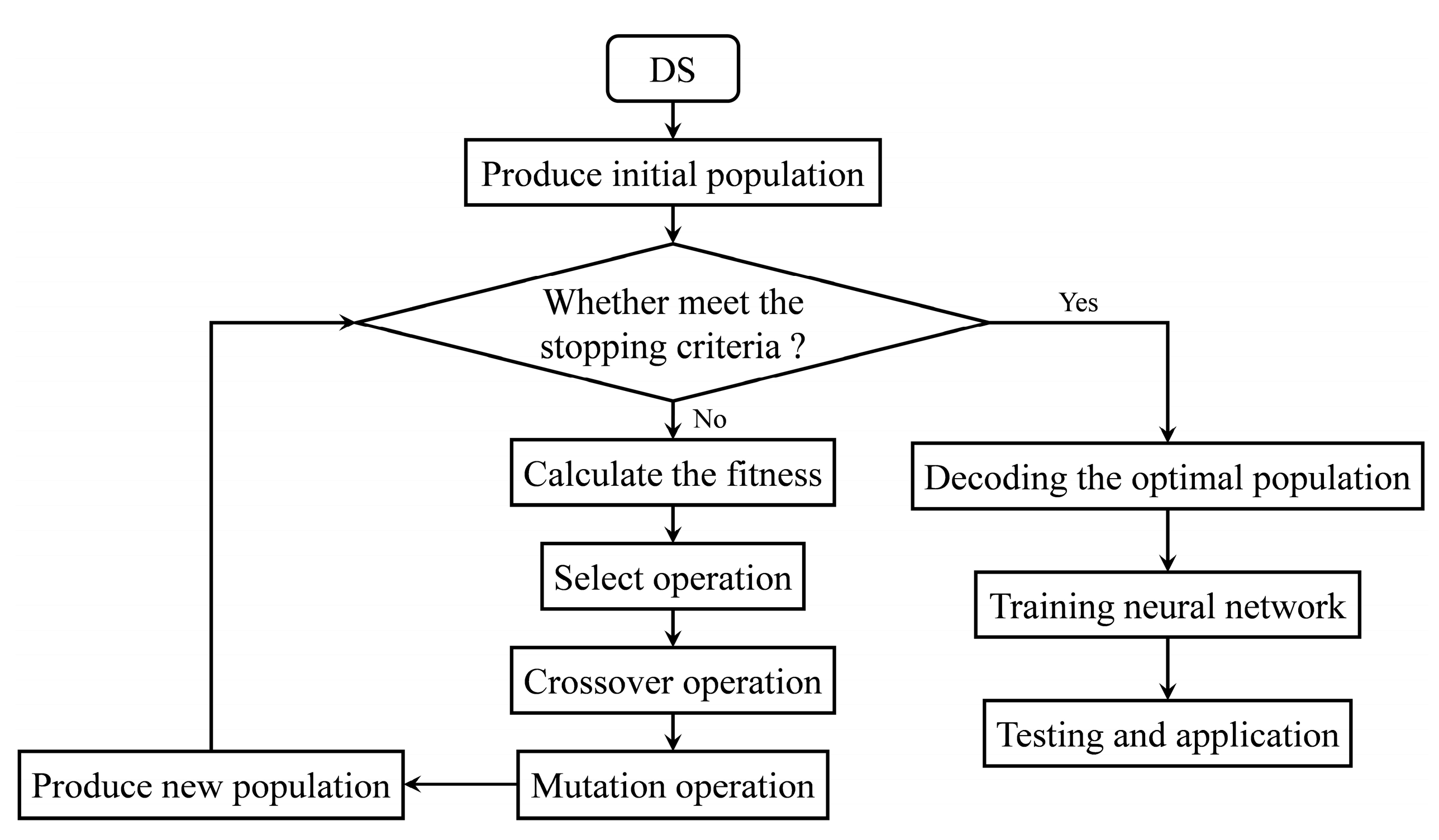
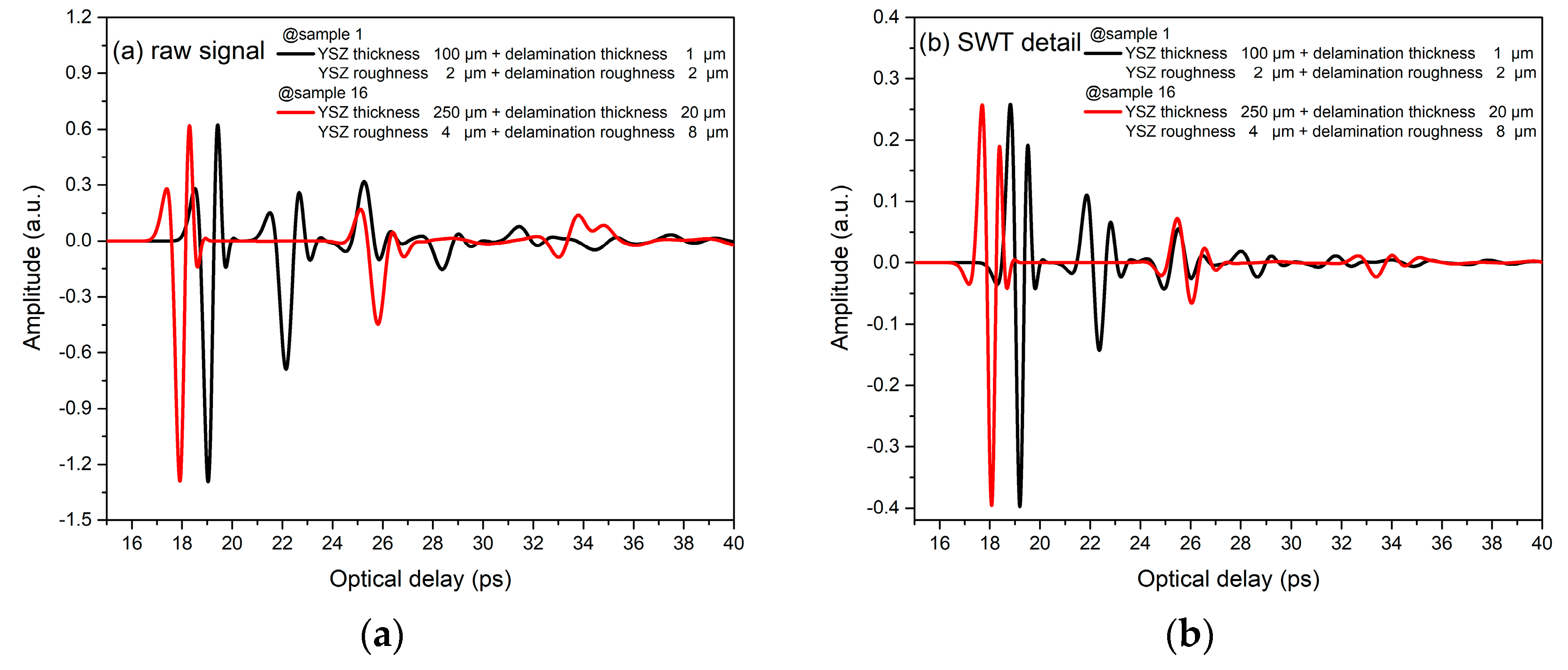
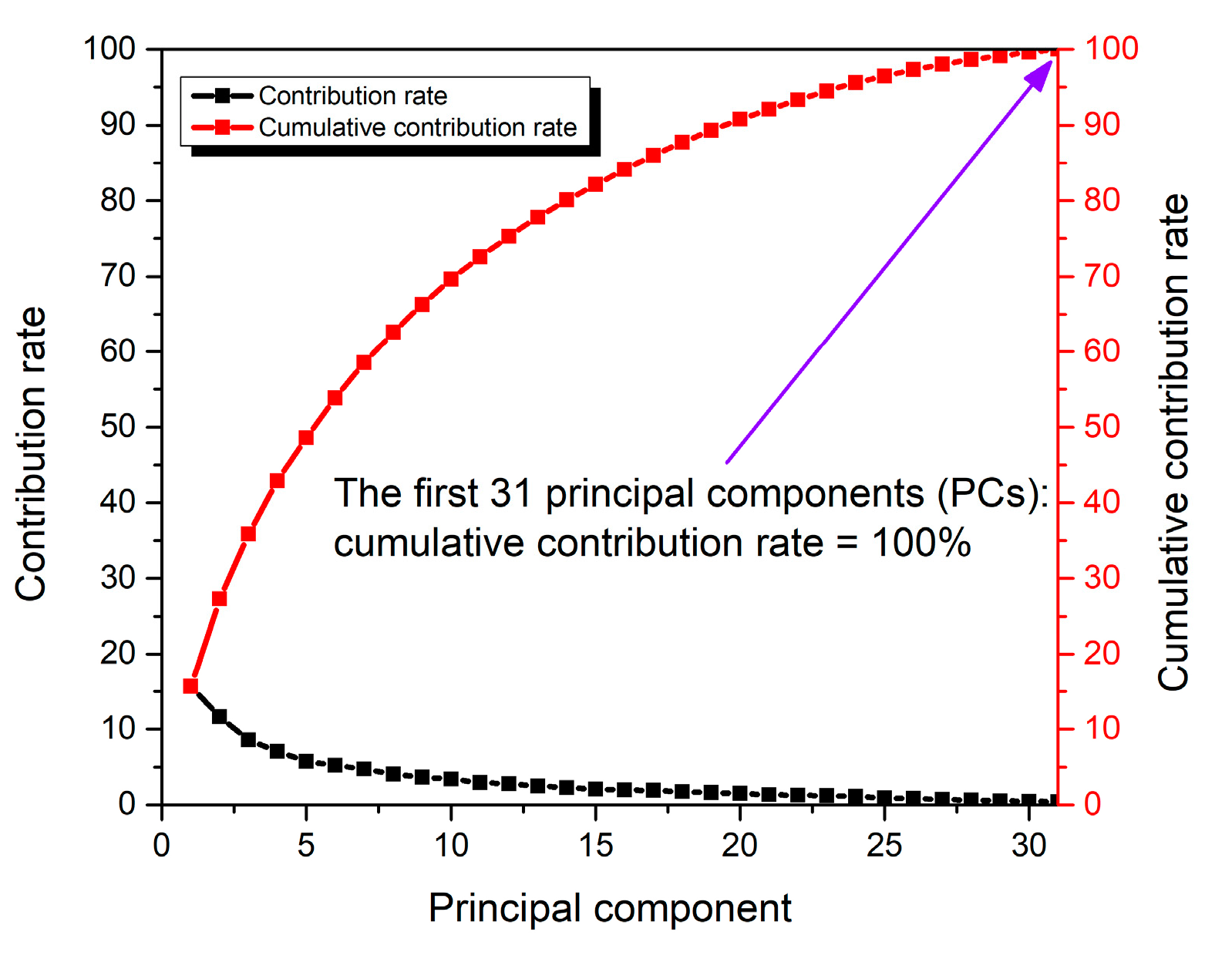

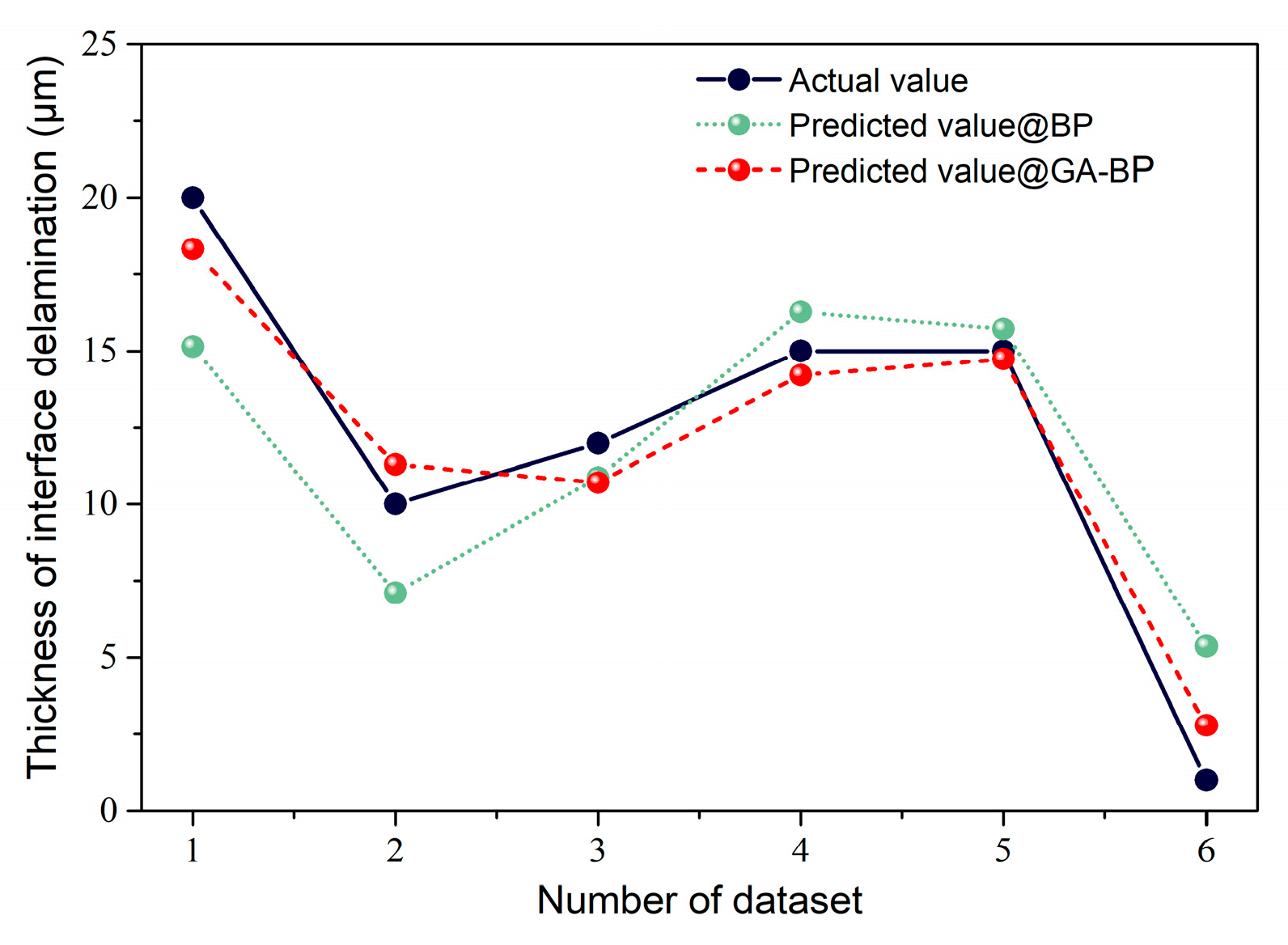
| Methods | Detectable Content |
|---|---|
| Ultrasonic waves | Elasticity modulus, thickness, bond quality |
| Eddy current | Thickness, porosity |
| X-rays | Thickness, porosity, pore structure |
| Infrared | Thickness, crack, delamination, degradation |
| Terahertz | Thickness, porosity, TGO, microstructure feature, delamination |
| Layer | Optional Thickness (μm) | Optional Roughness (Ra/μm) |
|---|---|---|
| YSZ top coat | 100~410 (interval: 10) | 2, 4, 6, and 8 |
| Interface delamination | 1, 3, 5, 8, 10, 12, 15, and 20 | 2, 4, 6, and 8 |
| Prediction Results | R2 | MSE | MSPE | MAPE |
|---|---|---|---|---|
| BP | 0.7370 | 2.9291 | 1.8636 | 2.1833 |
| GA-BP | 0.9511 | 0.5300 | 0.3011 | 0.3647 |
© 2020 by the authors. Licensee MDPI, Basel, Switzerland. This article is an open access article distributed under the terms and conditions of the Creative Commons Attribution (CC BY) license (http://creativecommons.org/licenses/by/4.0/).
Share and Cite
Ye, D.; Wang, W.; Yin, C.; Xu, Z.; Fang, H.; Huang, J.; Li, Y. Nondestructive Evaluation of Thermal Barrier Coatings Interface Delamination Using Terahertz Technique Combined with SWT-PCA-GA-BP Algorithm. Coatings 2020, 10, 859. https://doi.org/10.3390/coatings10090859
Ye D, Wang W, Yin C, Xu Z, Fang H, Huang J, Li Y. Nondestructive Evaluation of Thermal Barrier Coatings Interface Delamination Using Terahertz Technique Combined with SWT-PCA-GA-BP Algorithm. Coatings. 2020; 10(9):859. https://doi.org/10.3390/coatings10090859
Chicago/Turabian StyleYe, Dongdong, Weize Wang, Changdong Yin, Zhou Xu, Huanjie Fang, Jibo Huang, and Yuanjun Li. 2020. "Nondestructive Evaluation of Thermal Barrier Coatings Interface Delamination Using Terahertz Technique Combined with SWT-PCA-GA-BP Algorithm" Coatings 10, no. 9: 859. https://doi.org/10.3390/coatings10090859
APA StyleYe, D., Wang, W., Yin, C., Xu, Z., Fang, H., Huang, J., & Li, Y. (2020). Nondestructive Evaluation of Thermal Barrier Coatings Interface Delamination Using Terahertz Technique Combined with SWT-PCA-GA-BP Algorithm. Coatings, 10(9), 859. https://doi.org/10.3390/coatings10090859





